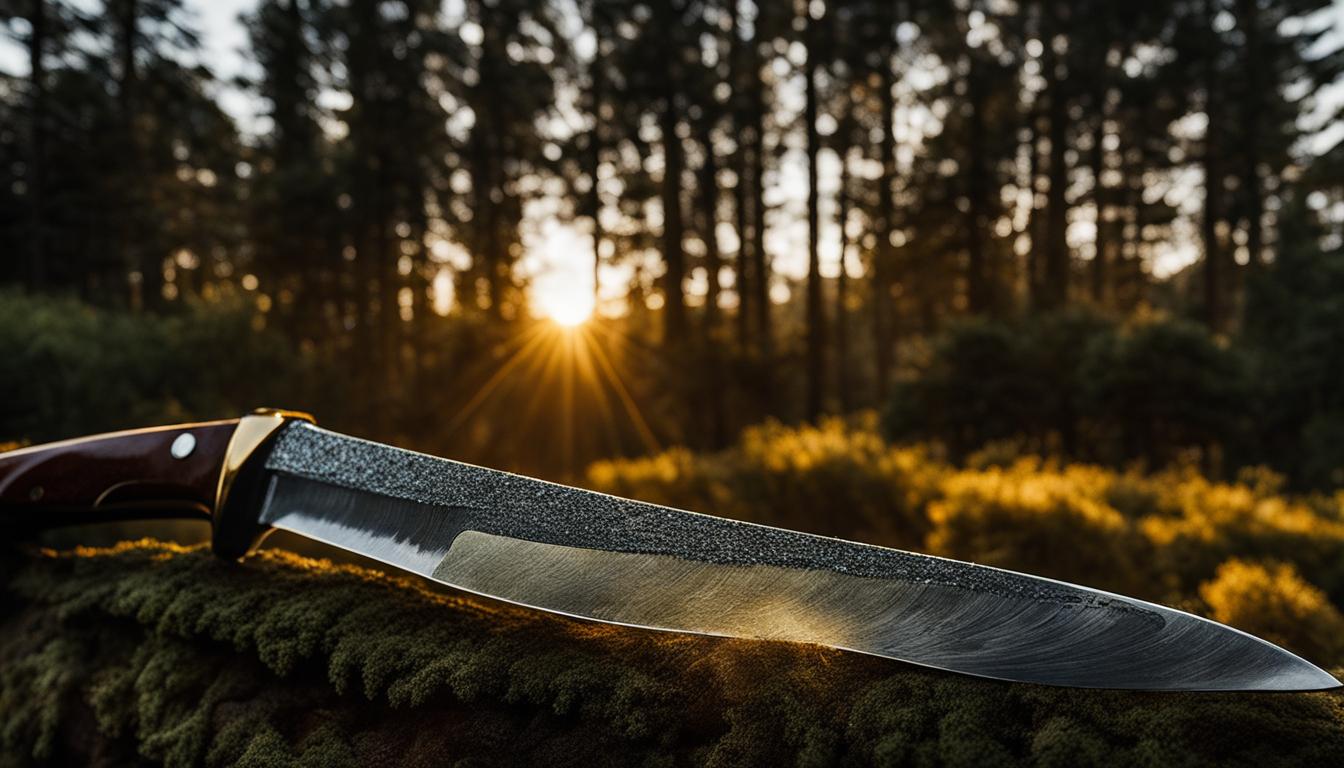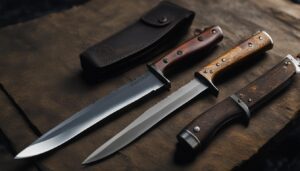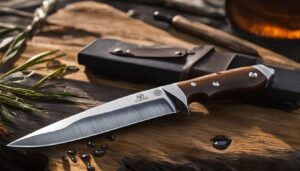When it comes to your hunting knife, rust is its worst enemy. Rust not only affects the appearance of the blade but also weakens its structure, compromising its performance and durability. Keeping your knife blade free from rust is essential for maintaining its sharpness and longevity. In this article, I will share with you the best tips to prevent rust on your hunting knife blade, ensuring it stays in perfect condition for all your outdoor adventures.
Key Takeaways:
- Steel knives are prone to rust due to the natural process of corrosion caused by the reaction between iron in the steel, oxygen, and water.
- Both high carbon and stainless steel knives can rust, although stainless steel takes longer.
- Knife patina, a yellowish color on carbon steel blades, actually protects the surface from rust.
- Montana Knife Company uses a process called Parkerizing to prevent rust on their high carbon steel blades. They also use Cerakote, a durable ceramic finish, for additional rust protection.
Rust vs. Knife Patina
Rust and knife patina are two different phenomena that can occur on knife blades. Understanding the difference between the two is essential for proper knife maintenance and rust prevention.
What is Rust?
Rust is the reddish-brown buildup that occurs when iron in steel reacts with oxygen and water. It is a form of corrosion that can deteriorate the blade if left untreated. Rust weakens the steel, causing it to become brittle and susceptible to further damage. It also affects the blade’s performance and appearance. Rust can form in small patches or cover the entire surface of the blade, depending on the level of corrosion.
What is Knife Patina?
Knife patina, on the other hand, is a natural protective layer that develops on carbon steel blades. It is a yellowish coloration that occurs due to exposure to air, moisture, and various substances. Knife patina is often considered desirable as it adds character to the blade and enhances its visual appeal. Unlike rust, knife patina forms a protective barrier on the surface of the blade, preventing further corrosion and rust formation.
While rust is harmful to the blade, knife patina is beneficial as it acts as a shield against rust and corrosion. It is important to note that knife patina only occurs on carbon steel blades and is not present on stainless steel knives.
In conclusion, rust and knife patina are distinct phenomena that can occur on knife blades. Rust is harmful and should be prevented and treated, while knife patina is a natural protective layer that enhances the blade’s durability. Understanding the difference between the two is crucial for maintaining and preserving the quality of your knives.
How to Keep Knives From Rusting
Preventing rust on your knife is essential to maintain its longevity and performance. By following these rust prevention tips, you can ensure that your knives stay in optimal condition and are ready for use whenever you need them.
Clean and Dry Thoroughly
After each use, it’s important to clean and dry your knife blade thoroughly. Washing the blade with warm soapy water and giving it a gentle scrub will remove any dirt, debris, or acidic residue that could contribute to rust formation. Once clean, make sure to dry the blade completely using a clean towel or cloth. Moisture is one of the main culprits of rust, so ensuring that the knife is completely dry is crucial.
Apply a Protective Layer
An additional step you can take to prevent rust on your knife is to apply a layer of blade wax or oil. This protective layer helps to create a barrier between the steel and moisture, preventing rust from forming. You can find specialized blade wax or oil products that are specifically designed for this purpose. Applying the wax or oil regularly, especially after cleaning and drying the blade, will provide ongoing protection against rust.
Care for the Sheath
In addition to taking care of the knife blade, it’s important to pay attention to the sheath as well. If your knife has a sheath, make sure to keep it clean and dry at all times. Moisture trapped inside the sheath can easily transfer to the knife blade and lead to rust formation. Regularly inspect the sheath for any signs of moisture or damage, and clean and dry it thoroughly when necessary.
| Rust Prevention Tips for Knives |
|---|
| 1. Clean the knife blade thoroughly after each use with warm soapy water. |
| 2. Dry the knife blade completely with a clean towel or cloth. |
| 3. Apply a layer of blade wax or oil to protect against moisture. |
| 4. Regularly inspect and care for the sheath to prevent moisture buildup. |
By implementing these rust prevention tips, you can keep your knives in excellent condition and ensure that they remain rust-free. Remember to clean and dry your knives thoroughly, apply a protective layer, and take care of the sheath. With proper maintenance, your knives will stay sharp, reliable, and ready for any task at hand.
Choosing the Right Knife Purpose
When it comes to selecting a knife, it’s essential to consider its intended purpose. Each knife is designed with specific tasks in mind, and using a knife for its intended purpose not only ensures optimal performance but also helps prevent damage to the blade.
For example, hunting knives are specially designed for field dressing game, skinning, and general outdoor use. These knives typically have a sturdy construction and a sharp, durable blade that can withstand rugged conditions. However, using a hunting knife for activities such as cutting wood or branches can compromise its structural integrity and potentially damage the blade.
Similarly, switchblades, known for their quick and easy deployment, are best suited for everyday tasks and self-defense purposes. Using a switchblade for cutting firewood or other heavy-duty tasks can put excessive stress on the mechanism and blade, leading to potential malfunctions or even breakage.
By understanding the purpose and limitations of different knife types, you can make informed decisions and choose the right knife for the job. This not only ensures optimal performance but also helps maintain the longevity of your knives.
| Knife Type | Intended Purpose |
|---|---|
| Hunting Knife | Field dressing, skinning, outdoor use |
| Switchblade | Everyday tasks, self-defense |
| Chef’s Knife | Cooking, food preparation |
| Pocket Knife | Everyday carry, utility tasks |
By using knives for their intended purpose and treating them with care, you can ensure their longevity and enjoy years of reliable performance.
Proper Cleaning and Drying Techniques
Keeping your hunting knife clean and dry is essential for preventing rust formation. By following the right cleaning and drying techniques, you can ensure that your knife stays in optimal condition for years to come. Here are some tips to help you maintain your knife:
Cleaning the knife:
- After each use, wash the knife with warm water and mild dish soap. Avoid using the dishwasher, as the high heat and abrasive detergents can damage the blade.
- Use a soft brush or cloth to remove any debris or residue from the blade. Pay special attention to the areas near the handle and the crevices of the knife.
- If there are stubborn stains or rust spots, you can use a specialized knife cleaner or a paste made from baking soda and water. Apply the cleaner to the affected areas and gently scrub with a soft brush or cloth.
Drying the knife:
- After cleaning, thoroughly dry the knife with a clean towel. Make sure to remove all traces of moisture as any remaining water can lead to rust formation.
- If possible, use compressed air to blow out any water that may be trapped in the handle or other hard-to-reach areas of the knife.
- Allow the knife to air dry completely before storing it or applying any protective coatings or oils.
By cleaning and drying your knife properly, you can prevent moisture buildup and minimize the risk of rust formation. Remember to always follow the manufacturer’s instructions for cleaning and care, as different knife materials may require specific methods. With regular maintenance and proper cleaning practices, your hunting knife will remain rust-free and ready for action.
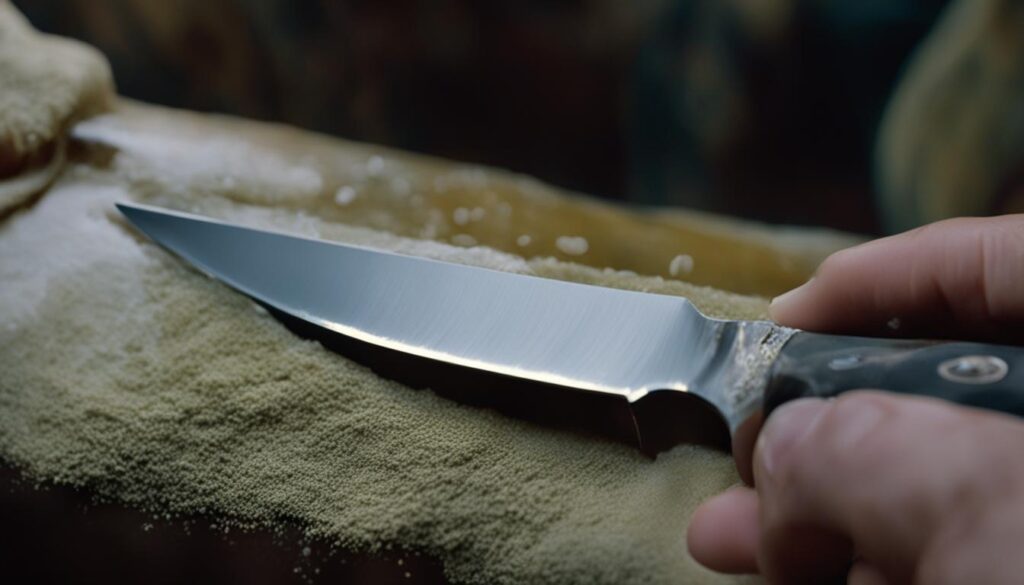
Regular Maintenance for Rust Prevention
Regular maintenance plays a crucial role in preventing rust on your hunting knife blade. By following a few simple steps, you can keep your knife in top shape and avoid the damaging effects of rust. Here are some essential maintenance tips:
Cleaning:
After each use, it’s important to clean your knife thoroughly to remove any dirt, debris, or moisture that can contribute to rust formation. Use warm water and mild dish soap to gently clean the blade, making sure to remove any food particles or residue. Avoid using abrasive cleaners or scrubbing pads, as they can scratch the blade’s surface.
Drying:
Once your knife is clean, thoroughly dry it with a clean towel to eliminate any remaining moisture. Pay special attention to areas where water can accumulate, such as the handle or between the blade and the handle. Proper drying is crucial, as even small amounts of moisture can lead to rust formation.
Oiling:
After cleaning and drying, it’s recommended to apply a thin layer of oil to the blade. This helps create a protective barrier against moisture and prevents rust from setting in. Choose a high-quality knife oil or mineral oil and apply it evenly across the entire blade surface. Be sure to wipe off any excess oil, as a thick layer can attract dust and dirt.
By regularly cleaning, drying, and oiling your hunting knife, you can significantly reduce the risk of rust formation and keep your blade in optimal condition. Remember to store your knife in a dry place, away from moisture and humidity, to maintain its rust-free state.
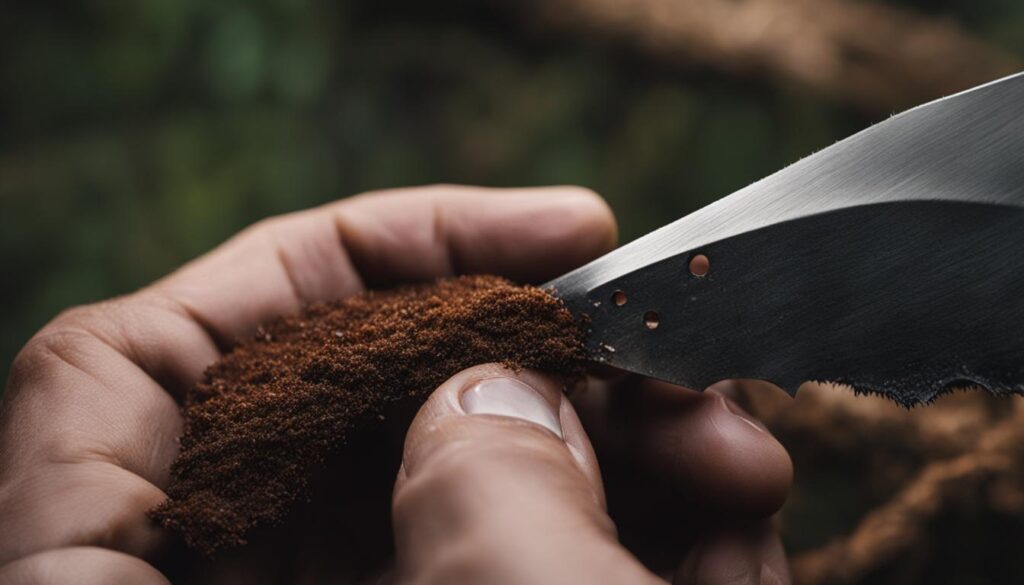

Choosing the Right Materials
When it comes to preventing rust on your hunting knife blade, choosing the right materials is essential. Knives made from rust-resistant materials can significantly reduce the risk of rust formation and ensure the longevity of your blade. Two popular options to consider are stainless steel and high carbon steel knives.
Stainless Steel Knives
Stainless steel knives are known for their excellent corrosion resistance. They contain a higher percentage of chromium, which forms a protective layer on the surface of the blade, preventing rust from penetrating the steel. Stainless steel knives are easy to maintain and are suitable for various outdoor activities.
High Carbon Steel Knives
High carbon steel knives, on the other hand, offer exceptional durability and edge retention. While they are more prone to rust compared to stainless steel, they can be treated to enhance their rust resistance. Applying a protective coating like Cerakote or Diamond-Like Carbon (DLC) can provide an additional layer of rust protection, making high carbon steel knives a viable option for those who prefer their unique properties.
“Choosing the right material for a hunting knife is crucial in preventing rust and ensuring its reliability in the field.”
When making your decision, consider the specific requirements of your intended use. Stainless steel knives are ideal for those who prioritize low maintenance and reliable rust resistance. High carbon steel knives, with the proper treatment and care, offer exceptional performance and versatility. Whichever material you choose, make sure to clean, dry, and store your knife properly to maximize its rust-resistant properties and prolong its lifespan.
Conclusion
Preventing rust on my hunting knife blade is crucial for its longevity and performance. By understanding the factors that cause rust, using proper cleaning and drying techniques, performing regular maintenance, choosing the right knife purpose and materials, and implementing smart storage practices, I can significantly reduce rust formation.
Following these knife rust prevention tips will help extend the life of my knife and ensure it stays sharp and in good condition for years to come. By cleaning and drying my knife thoroughly after each use, applying a layer of blade wax, and caring for the sheath, I can prevent moisture from reaching the steel and minimize the risk of rust.
Regular maintenance, such as applying a thin layer of oil, sharpening the blade, and storing the knife in a dry place, is essential for rust prevention. Choosing knives made from rust-resistant materials like stainless steel or high carbon steel, and considering additional coatings like Cerakote or Diamond-Like Carbon (DLC), can also provide added protection against rust.
By following these guidelines and implementing these strategies, I can keep my hunting knife rust-free and ready for action whenever I need it. With proper care and maintenance, my knife will continue to serve me well in the field and ensure that rust doesn’t become an issue.
FAQ
Why do steel knives rust?
Steel knives are prone to rust due to the natural process of corrosion caused by the reaction between iron in the steel, oxygen, and water.
Can stainless steel knives rust?
Yes, both high carbon and stainless steel knives can rust, although stainless steel takes longer.
What is knife patina?
Knife patina is a yellowish color that develops on carbon steel blades due to exposure to air, moisture, and other substances. It actually protects the surface of the blade from rust and adds character to the knife.
How can I prevent rust on my knife?
To prevent rust, it’s essential to clean and dry the blade thoroughly after each use. Applying a layer of blade wax and ensuring the sheath is clean and dry also helps prevent rusting.
What should I do after using a knife?
After using a knife, wash it with warm water and mild dish soap by hand. Avoid using the dishwasher. Dry the knife immediately and thoroughly with a clean towel.
How often should I maintain my knife to prevent rust?
Regular maintenance is vital for keeping knives rust-free. Applying a thin layer of oil after cleaning and drying helps protect the blade. Regular sharpening and proper storage in a dry place are also important.
Are there materials that are less prone to rust?
Yes, stainless steel, high carbon steel, ceramic, and titanium are all good choices for rust resistance. Coatings like Cerakote or Diamond-Like Carbon (DLC) can provide additional rust protection.
How can I choose the right knife for its purpose?
It’s important to use a knife for its intended purpose to prevent damage to the blade. Avoid using hunting knives for activities like cutting wood or using switchblades for cutting firewood.
